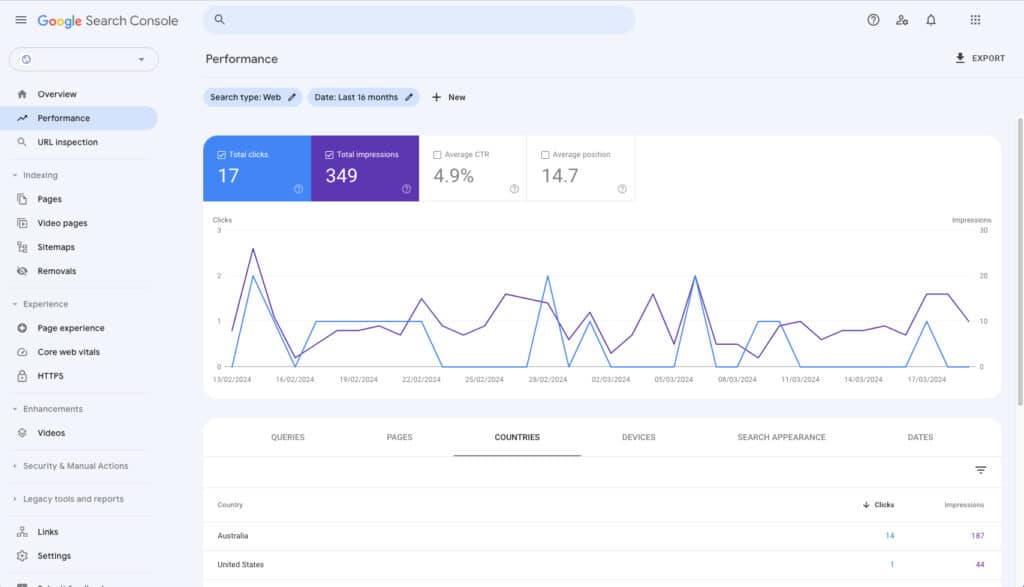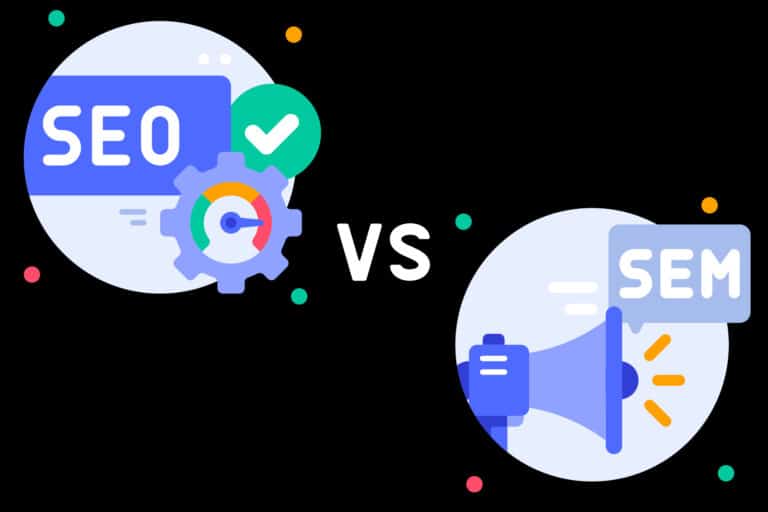As the co-founder and digital lead at 5 Twelve, I chat with businesses daily who express to me their struggle with getting seen online without having to pay for each impression or click.
They typically have already spent thousands on a website, dabbled in social media, and even engaged a digital marketing agency or two to assist them – but to no avail. I often tell businesses quite bluntly, that there is no point in spending $30K on a website and social media marketing to look pretty and feel like an extension of your soul if no one can actually find you or understand how you can help them. At the end of the day, the phone ringing, the calendar getting booked, and the online sales are what business is all about!
It’s not to say these two things are mutually exclusive but indicates to me that the focus may be too lasered in the wrong areas.
I’ve decided to put together an article to help pinpoint some areas these businesses could redirect focus to from both an SEO and digital marketing perspective.
1. Your Website Isn't In Google's Index
When someone tells me “I can’t find myself on Google!”, the first thing I do is check to see if Google has indexed their website. Simply Google Search (replace yourwebsite.com with your domain):
site:yourwebsite.com
If your website doesn’t show up, it’s likely not indexed. This could be due to a number of reasons:
- Robots.txt Disallowance: The website’s robots.txt file mistakenly instructs search engine crawlers not to index the site or specific pages.
- Noindex Tags: Pages tagged with a ‘noindex’ directive either in the meta tags or HTTP headers are explicitly told not to be indexed by search engines.
- Crawl Errors: Issues like server errors (500), not found errors (404), or access denied errors (403) prevent Googlebot from accessing and indexing the site.
- Slow Loading Speed: Extremely slow-loading pages may be skipped by Google’s crawlers, leading to non-indexing.
- Penalties and Sanctions: The website has been penalised by Google for violating search engine guidelines, such as through the use of black-hat SEO techniques.
- Poor Quality or Duplicate Content: Websites with substantial duplicate or low-quality content may be deemed unworthy of indexing.
- New Website: Newly launched websites may not be indexed immediately as it takes time for Google to discover and process them.
- Blocked by .htaccess: Incorrect configuration of the .htaccess file can inadvertently block search engines from accessing the site.
- Domain Issues: Problems related to domain registration, such as a lapsed registration or the site being flagged for spam, can affect indexing.
- Temporary Site Downtime: If the site was down when Googlebot tried to crawl it, the pages might not be indexed.
To get your site indexed, log onto Google Search Console and submit each webpage and your sitemap to be indexed. If there are any issues, these will be flagged in the platform for you or your developer to fix before submitting again.
If your website’s pages do show up then congratulations! Your website is in Google’s index and therefore could rank for particular search queries in particular regions. If you explore Google Search Console, you’ll be able to see what search queries Google is serving your web pages for and how many impressions (views on Google Search) and clicks (clicks on your listing) you’re currently receiving. Unfortunately, if you’re not showing up for your business name and/or any relevant search queries, and a good handful of your webpages are missing from Google’s index, then we will have to investigate further into why that’s the case.
2. Your Website is New
With a new website and/or business launch, it is so exciting to show everyone! Nine times out of ten though, one of your relatives, friends or even staff will try and Google you or your [industry][location] to find the new website and report back that they cannot find it.
Initially, Google needs to discover your new site (NOTE: Google is its own private website, NOT the World Wide Web). This process typically begins when Google’s algorithms identify links to your site from other indexed pages or when your site is directly submitted to Google via Search Console. Without external links or direct submission, your new site may remain under the radar for some time.
Upon discovery, Google’s robot crawlers read and assess your website’s content, structure, and technical setup. For new websites, this process is crucial as it marks the first assessment of your site’s relevance and quality.
After crawling, Google attempts to index your site’s pages, which involves analysing and storing the pages in its database. This stage is influenced by the quality of the content, the site’s adherence to SEO best practices, and the overall user experience. High-quality, unique content is more likely to be indexed quickly.
As Google finds, crawls and indexes your web pages, it begins to understand who you are, where you’re located and what you do. If this information is not clear, it simply would not show your website for relevant terms – your brand, your [industry][location] and more – and hold your webpages as ‘Discovered, not indexed’.
The ‘hack’ to push this process forward and quickly identify any issues is to submit each page and your sitemap through Google Search Console.
3. Your Website Sucks
Sometimes, even the flashiest of websites are often the suckiest from a technical and SEO point-of-view. There are a number of ways I could look at a website and yell “This Sucks!”
a. Bad Content Management System (CMS)
Your choice of CMS is foundational to your website’s performance and its potential to rank on search engines. An ineffective CMS can hinder your ability to publish, manage, and optimise your content for SEO, impacting everything from site speed to mobile responsiveness.
Stay away from indie, ‘free’ and ‘easy’ web builders – ones typically bundled in with website and email hosting such as GoDaddy, Wix or Joomla. Oftentimes too, a completely custom-built website from a developer may have just the same limitations – PLUS you’re at the mercy of the developer for any changes you want done to the website.
If your current CMS is holding you back, consider migrating to a more SEO-friendly platform. WordPress is ideal in most cases due to its level of flexibility, user-friendliness and SEO-friendliness.
b. Poor Speed and Load Time
Website speed is a critical factor in user satisfaction and SEO rankings. Slow load times can lead to increased bounce rates, decreased engagement, and lower search rankings. Google prioritises fast-loading sites, considering speed a key factor in providing a positive user experience.
Some common causes for poor load time:
- Unoptimised or Excessive Images/Video: Large image files can significantly slow down page loading times.
- Excessive Use of JavaScript and CSS: Overuse of these elements can lead to bloated web pages that take longer to load.
- Poor Website Hosting: A low-quality hosting service can result in slow server response times, affecting overall site speed.
- Heavy Use of Plugins or Widgets: While plugins add functionality, too many can bog down your site, increasing load times.
c. Lack of Structure
A well-structured website is crucial for both user navigation and SEO performance. A logical hierarchy and clear navigation paths enable search engines to understand and index your content effectively, while also providing a better user experience. A lack of structure can confuse visitors and search engines, leading to poor indexing and user engagement.
Ensure you’re:
- Implementing a Logical Hierarchy: Organise your content in a clear, hierarchical manner that reflects the importance and relationship of pages. Use categories and subcategories to structure your content logically i.e. categories for products.
- Simplifying Navigation: Ensure your site navigation is intuitive and consistent across all pages. Use breadcrumb navigation to enhance user orientation and SEO.
- Optimising URL Structure: Create descriptive, keyword-rich URLs that reflect the content of the page. Keep URLs simple.
- Using Header Tags Effectively: Employ header tags (H1, H2, H3, etc.) to structure content clearly on each page. This helps search engines understand the organisation and relevance of your content.
d. Bad User Experience (UX)
User experience (UX) encompasses all aspects of a visitor’s interaction with your website. A negative UX can deter visitors from staying on or returning to your site, directly affecting your bounce rate, time on site, and ultimately, your SEO rankings. Google’s algorithms increasingly prioritise sites that provide a positive user experience, making UX a critical component of your SEO strategy.
Ensure you’re double-checking the experience on mobile, there are minimal intrusive ads or pop-ups, and there are clear and distinct call-to-actions (a pathway for users to go) on each page.
4. You're Overlooking The Basic Principles
In the quest for cutting-edge SEO strategies, it’s easy to overlook the fundamental principles that form the bedrock of successful search engine optimisation. At its core, SEO isn’t just about appeasing algorithms—it’s about reaching and communicating effectively with your target audience.
a. Need For Basic SEO Practice
The foundation of effective SEO lies in mastering the basics. A solid grasp of fundamental SEO practices ensures your website communicates efficiently with search engines and aligns with user expectations.
Some basic SEO practices can be seen across:
- Headings and Tag Structure:
- Use H1 for main titles (typically the target [industry][location]), H2 for section headings, and H3 (and beyond) for sub-sections.
- Helps search engines understand the content hierarchy and improves indexing.
- Title Tags and Meta Descriptions:
- Include the primary keyword in the title tag, keeping it under 60 characters.
- Craft compelling meta descriptions to improve click-through rates, summarising page content within 160 characters with a CTA.
- Keywords:
- Incorporate keywords naturally into content, especially in headings and the first paragraph.
- Avoid keyword stuffing; prioritise natural reading context and user experience.
- Original Photos:
- Use high-quality (500KB to 2MB), original images and tag them with descriptive, keyword-rich file names and alt attributes.
- Calls-to-Action (CTAs):
- Place clear, compelling CTAs on each main page to guide users towards desired actions (e.g., purchase, subscribe, contact).
- Improves conversion rates by turning passive readers into active participants.
b. Forgetting To Address Your Target Audience Through Content
Effective content creation hinges not on self-promotion but on addressing the needs and questions of your target audience. Yes, your website can be a portfolio of your work, who you are and what you do, but if acquiring new business is the goal (as it should always be), then you will need to ensure that your content strategy serves your audience best. Ways to ensure you’re addressing your target audience include:
User-centric Content: Shift focus from company-centric narratives to user-centric solutions. Your content should mirror the interests, challenges, and questions of your audience, not merely serve as a platform for self-aggrandisement.
Answer FAQs: Utilise your blog and key content areas to provide clear, concise answers to frequently asked questions (FAQs) related to your industry. This approach not only positions you as a helpful resource but also improves your SEO by matching content with common search queries.
Benefits Over Features: When mentioning your services or products, focus on how they benefit the user rather than listing features. This helps the audience visualise the value you bring to their lives or businesses.
Use Relatable Language: Craft your messages in a language that resonates with your audience. Avoid jargon and technical terms unless they are widely understood by your target demographic (I’m eyeing you, lawyers).
Engagement Through Education: Provide educational content that empowers your audience. Guides, how-tos, and industry insights establish your credibility and encourage deeper engagement with your brand.
5. It's Simply Low Quality or Irrelevant Content
As we’ve already just been through, content quality directly influences your website’s ability to engage users and perform well in search engine rankings. When content fails to meet the needs of your audience or lacks relevance to your niche, it diminishes user experience and your site’s SEO potential.
There are some key areas where I see content quality often falls short:
- Minimalist Websites: A website with minimal content can appear sleek and modern, but if it lacks comprehensive information about your services, products, and value proposition, it may not satisfy user queries or search engine requirements for informative content. While embracing minimalism in design, ensure your site’s content is still rich enough to guide and inform users effectively.
- Heavily AI-Generated Content: While AI tools can assist in content creation, overreliance on them without proper oversight can lead to generic, uninspired content that lacks the human touch. AI-generated content often misses the nuances of language that engage readers and reflect brand personality. Always review and edit AI-assisted content to ensure it meets your quality standards and genuinely reflects your brand’s voice.
- Doesn’t Address Core Questions: Content that fails to clearly explain what you do, where you do it, and how much it costs leaves visitors with more questions than answers. This lack of clarity can drive potential customers away to competitors who provide the information they’re seeking. Ensure your content directly addresses common customer questions, including detailed descriptions of your offerings, location-specific information, pricing models, and why customers should choose you over competitors.
6. Lack of Trust Factors and Authority
Trust and authority are crucial for not only attracting but also retaining users and improving your website’s SEO. Google’s emphasis on E-E-A-T (Experience, Expertise, Authoritativeness, and Trustworthiness) underscores the importance of establishing a site as a credible source of information.
Check out our article on E-E-A-T to learn more.
While not a direct Google ranking factor, domain authority (DA) is a useful metric to gauge a website’s likelihood to rank in search engine results. Being listed on other websites, especially those with high Domain Authority, can provide valuable backlinks to your site. This not only helps in improving your own DA but also boosts your SEO efforts by signalling to search engines that your website is credible and authoritative.
Listings on reputable websites and online directories increase your online footprint, making your business more visible to search engines and potential customers.
7. Your Competition is Fierce or Your Market Isn't There
When your niche is highly competitive, standing out requires a combination of consistency, innovation, and strategic SEO. Regularly updating your website with fresh, high-quality content is key. Consistency in your SEO efforts, social media presence, and content updates signals to search engines and users that you’re an active, relevant player in your industry.
Keep abreast of the latest industry trends, Google algorithm updates, and competitor strategies. Innovate your content and offerings to meet emerging needs and interests, positioning yourself as a forward-thinking leader in your niche.
Conduct thorough competitor analysis to understand their strengths and weaknesses. Look for gaps in their content or areas they’ve overlooked. By offering something unique or of higher quality, you can carve out your own space even in crowded markets.
On the other hand, sometimes the market is not there. A lack of search volume for your products or services indicates limited market interest. This can be found by doing a quick Google Search and trying Google’s Keyword Planner Tool. Sometimes, the market needs to be cultivated.
Use your platform to educate potential customers about the value and benefits of your offerings. High-quality, informative content in the form of blogs can generate interest and demand by capturing the interest of the general population and funnelling them to your solution.
Be ready to pivot your strategies based on performance data and market feedback. The digital landscape is ever-changing, and flexibility can be one of your strongest assets.
Anything I missed?
Navigating the complexities of digital visibility is a common challenge for many businesses, and just those daily interactions I have with businesses reveal a universal struggle to gain organic online visibility.
These are the major areas I tend to dive into when doing an audit and strategy for my clients to bolster up their online visibility and get some conversions in. Just like anything in the digital marketing space, nothing is one-size-fits-all and there can sometimes be incredibly simple or incredibly complex reasons for why a website isn’t ranking on Google. What else do you think I could’ve added?
At 5 Twelve, we provide quality and results-driven SEO services to our clients. If you’d like to chat with me or my team, please enquire online today.





